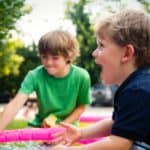During my many years at the Tennessee School for the Deaf, I was often asked if my deaf students were a challenge because of their deafness.
I would always reply, “At TSD, my students are great; it’s the adults that drive me crazy”.
I said that because it didn’t take me long to learn that kids in the deaf community are just like their hearing counterparts in public school.
They laugh, play, love, and learn just like any other kid. The deaf child also brings into the classroom the same learning challenges that any other child brings. If there is a difference in the hearing and deaf, we might find the difference in the impact on some of the learning challenges.
Like I said, the deaf child is like the hearing child in their ability to learn. At first, the deaf child’s biggest hurdle is language acquisition. A hearing child is constantly exposed to language as they grow up. They hear their parents and people around them talking, and they are exposed to language via TV and radio.
The deaf child, if exposed to language early, either with deaf parents or hearing parents that are dedicated to exposing their child to manual communication, will thrive. Unfortunately though, many hearing parents do not expose the deaf child to manual communication, thus delaying their child in their ability to pick up language. Fortunately, schools for the deaf across the USA are working to correct this, and are developing programs to reach out to parents of deaf children.
When I started working with SOI and IPP in 2000, we were unsure if these programs were doable with the deaf population. We soon learned that not only were SOI and IPP doable, but that the adjustments needed to be made were very minimal.
We first focused much of our attention on IPP (Integrated Practice Protocol), which is SOI’s vision and sensory integration program.
We thought that due to deafness, this was a good place to start. Once again, our deaf children scored much the same as the hearing child. The biggest exception is of course balance, which is controlled with the inner ear. Through work on the rocker and balance boards, we found this could be greatly improved.
Another area of concern, which is what made IPP so advantageous, was our students’ vision skills. Deaf children rely on their vision not only to navigate the world, but to communicate with others. If some part of their vision system is off, their ability to learn is hampered. A lack of focusing skills can lead to early eye fatigue and an inability to keep up in class. This is a result of not being able to keep up with class discussions. Many teachers of the deaf introduce information on boards and screens in front of the class. If students have trouble shifting focus from their desk to the screen, and back to their desk, they will fall behind during class time.
In our work with SOI, we found that students scored comparable to hearing children. Many of our deaf students struggled with semantics. This is probably due to language delays many of our students experienced. But this being said, hearing children also struggle with semantics. I just don’t think hearing students struggle to the degree of deaf students do. The way SOI is progressively set up, semantic skills are greatly improved which leads to greater classroom success.
My experience working with students at TSD with SOI was amazing. We found that most of our students enjoyed coming to the IPP lab. This was because the programs were designed on their level and the students immediately felt success. And because their programs were a challenge, our students felt true accomplishments as they continued their journey with SOI and IPP.
At the end of the year, students who finished their program were recognized at our awards day in front of the school. I always love to see them beam in front of their fellow classmates. But, the best part of that day was not only giving certificates to those who completed their SOI programs, but seeing the same students being recognized for other achievements.
I found it very satisfying knowing that their work in SOI-IPP allowed them to achieve success in many parts of their school life. I also loved seeing former SOI students being recognized for their academic and vocational achievements that same day. Many of those students struggled in school prior to their SOI-IPP training. After completion of their programs they not only improved their grades, but were recognized for excelling in different academic and vocational areas.
And, that’s not all. Many of those same students went on to college and to the workforce to succeed in the story of life. Now that’s powerful.
written by: Richard Davis






